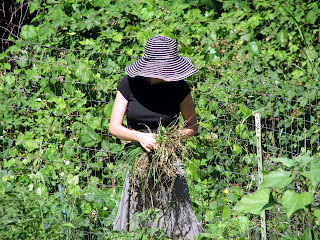Camp Verdugo Oaks in Castaic, CA, hosted the 2009 Griffin Dyeworks Fiber Retreat. From our previous blog, you caught some glimpses of wonderful activities we as a family engaged in. One of them, an ancient craft practiced throughout the world, was basket weaving!
In the hands of a masterful craftsperson, flat and round reeds of assorted widths and diameters and seagrasses are trasnformed into works of functional art. Basket weaver extraordinaire Therese Calhoun (stylish ripped jeans below) taught a group of eager students how to make two types of baskets, the Irish Potato Basket, and the Egg Basket. Therese explained to us that basket weaving is the one craft that cannot be accomplished by automation and is largely still only accomplished by human hands.
Here, Therese is showing the first part of the Egg Basket, beginning with two flat hoops set perpendicularly, intersecting at the middle.
Daddy and Ricky both created an Egg Basket. Sitting side by side on a worn rug, they shared clippers, and some valuable father-and-son time.
When the hoops were in place, which would become the rim and handle of the basket, the next step was to create the "God's eye." Using a flat 1/4 inch reed, which has been soaking in water to maintain its workabilty, a criss-crossing pattern is made at the junction of the two hoops.
Next, round reeds with a diameter of about 3/8" were cut to desired lengths to create the cradle of the basket. The ends of these "ribs" were inserted into the God's eye, and one can see the form of the basket taking shape.
Then, the weaving begins! Round reeds of various diameters are saturated in water. The longer they sit in water the better, as they can split or crack easily as they are woven. Lengths between 5 feet and 7 feet were used and woven into the ribs, with the ends tucked into the weaving. Additional ribs are added to maintain a tight weave, and to give it structural strength. This part of the project took time and patience. Each length of reed must be worked quickly as it dries fast. It also sucks moisture from the hands. Last year, one of the students took her basket to the camp pool, reeds and all, to keep them wet as she wove in her bathing suit!
Daddy, determined to finish his basket, had stayed up until 1 AM Sunday early morning. The camp was tranquil, the crafters were all asleep, and with a mountain lion possibly lurking at the edge of the shadows, Daddy wove in the dim light of a lamp. He wondered if a mountain lion shared the same curiosity as domestic cats with a ball of yarn, because from far away, the coiled reeds and the ends of the reeds, flailing in the air as he wove, looked awfully enticing!
 That Sunday morning, after breakfast, Daddy completed his basket with seagrass wrapped around the handle. Ricky had just a bit more to do with his basket, and Therese suggested some interesting alternatives to use for weaving such as strips of denim and fibers.
That Sunday morning, after breakfast, Daddy completed his basket with seagrass wrapped around the handle. Ricky had just a bit more to do with his basket, and Therese suggested some interesting alternatives to use for weaving such as strips of denim and fibers. All in all, the basket weaving was a wonderful class. Certainly, it is a craft that is timeless, and its true artisans like Therese will continue to create beautiful works. Daddy and Ricky are proud of their creations, and will always remember the time spent together weaving baskets.
All in all, the basket weaving was a wonderful class. Certainly, it is a craft that is timeless, and its true artisans like Therese will continue to create beautiful works. Daddy and Ricky are proud of their creations, and will always remember the time spent together weaving baskets.

























































